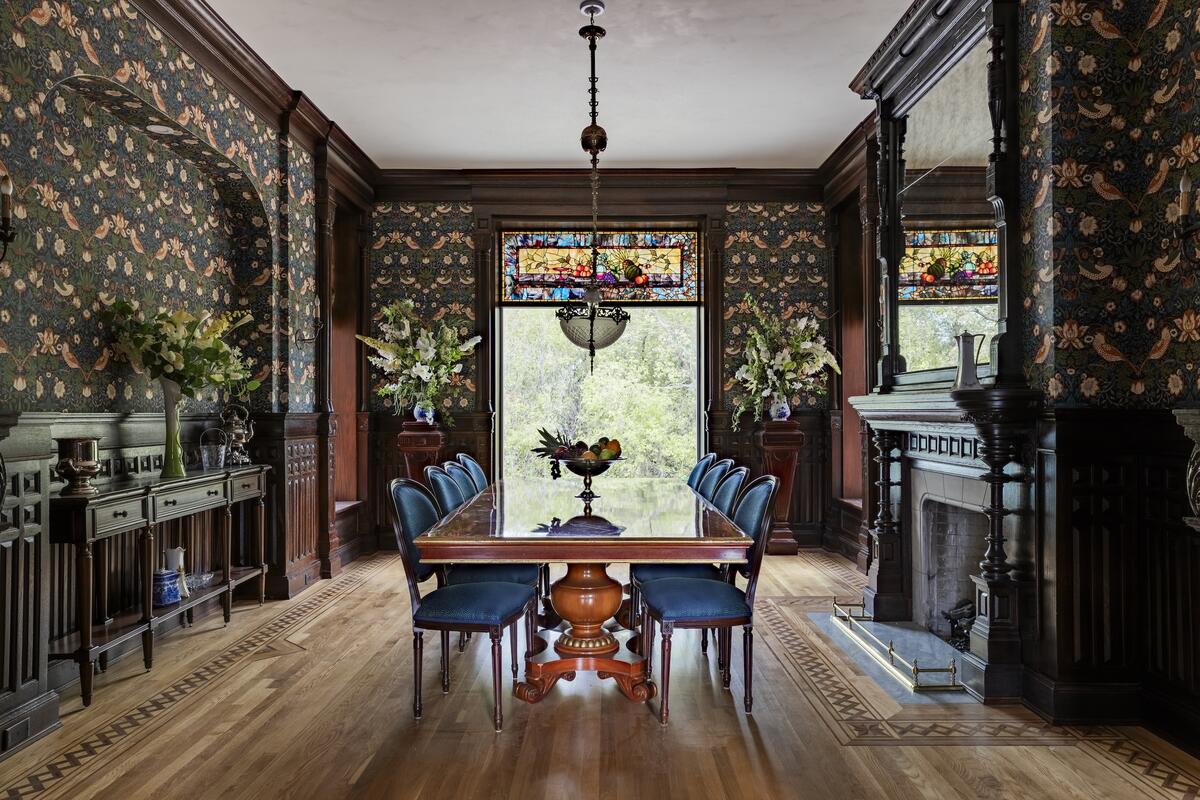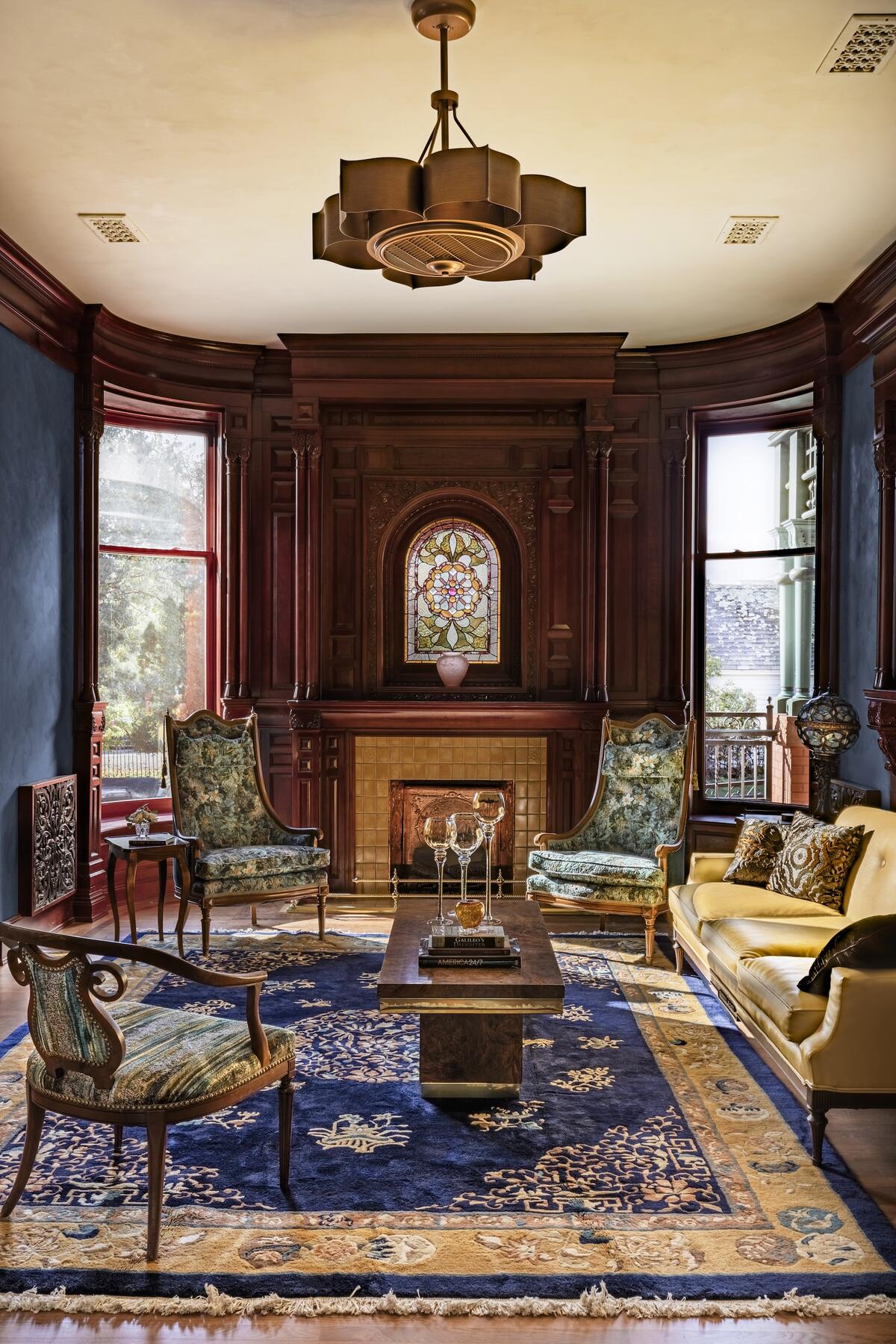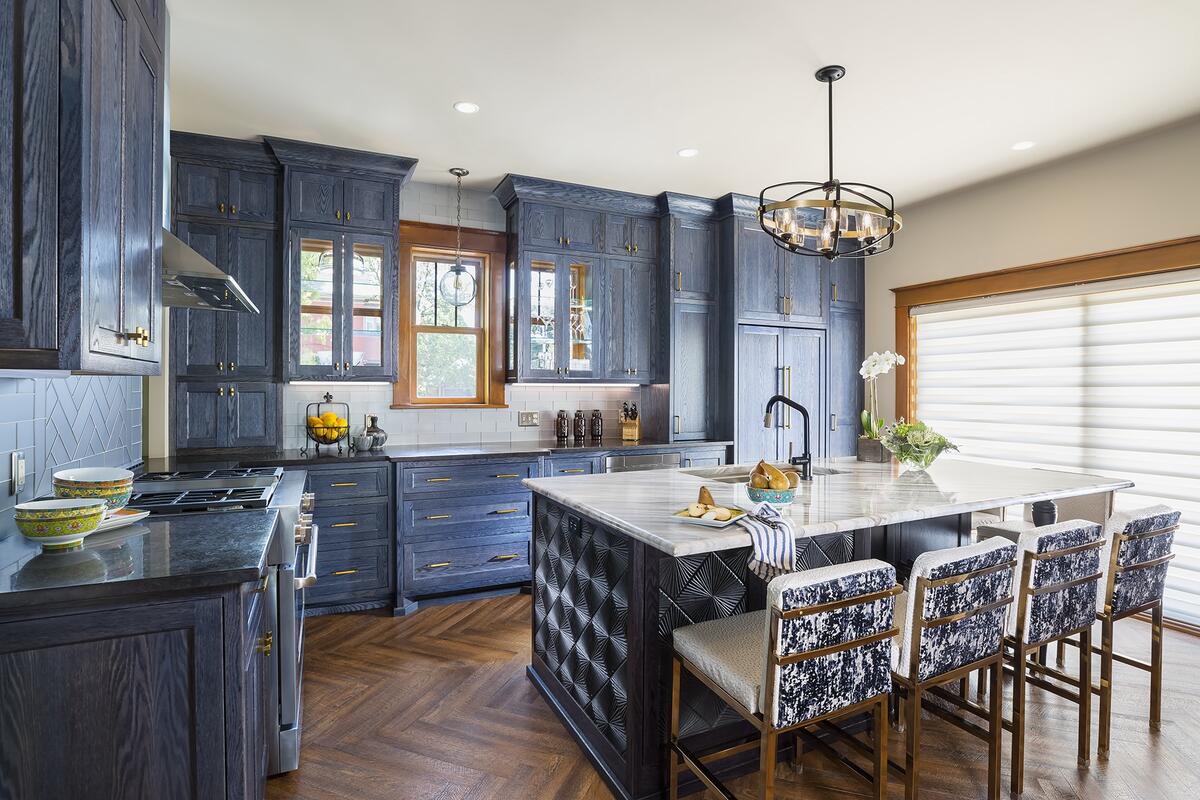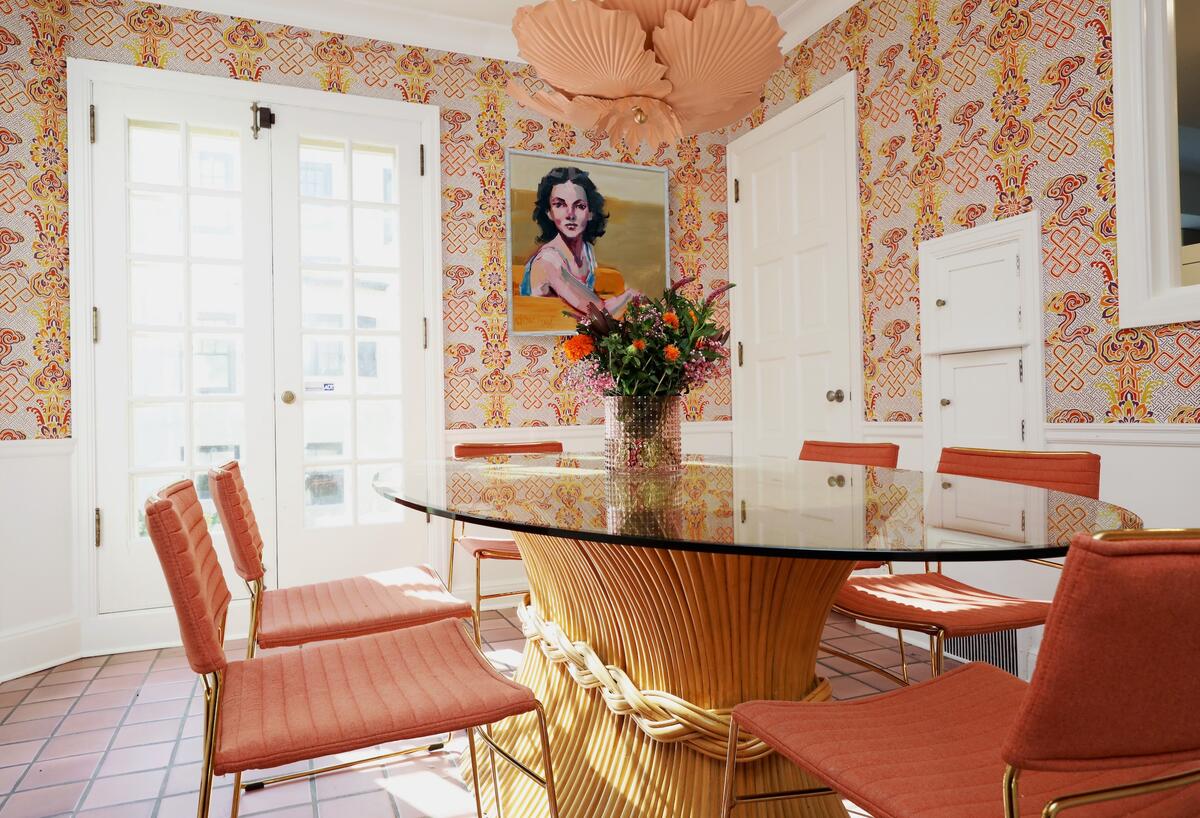The 50 States Project is a series of candid conversations with interior designers across the country about how they’ve built their businesses. This week, Minneapolis-based designer Carter Averbeck of Omforme Design tells us about helping homeowners see the potential in upcycled pieces, the biggest misconception he sees about sustainable design practices, and how tastes are shifting away from generic styles and toward the unique.
When did you decide to launch your firm?
There was no such term at the time, but today you would call my family “flippers.” My parents would buy the worst house on the best block that they could afford, and then we would turn things around. We’d pore over magazines like Architectural Digest—all the beautiful images—then figure out how to create that on an extreme budget. Sometimes it took a couple months, sometimes a year and a half. I was never really in a house for more than two years for the first 10 years of growing up.
Wow. What did that teach you about home?
It taught me that you can create a home anywhere—literally. It also taught me that if you’re given a bunch of hay, you have to learn how to spin gold.
I went to school for fine art, then I got a scholarship to go overseas and study under a fresco master in Barcelona. When I came back to the United States, I had a real passion for painting murals and opened a firm called Trompe Decorative Finishes for my artwork, decorative painting and mural work for commercial projects. When I started Omforme in 2012, I was going through a personal crisis and had to make a life change. I thought, “I’m going to go back to something I know incredibly well,” which is transforming furniture and interiors.
What did you want the firm to be, and how did you start attracting that business?
Ecological impact is very important to me. My concept from the very beginning is we have amazing furniture all around us—we don’t really have to buy new, because the older stuff is built really well. Let’s turn it into penthouse-worthy stuff, because it’s there for us to use.
Was there an appetite for that? And was that enough, or what made you want to expand into interiors?
The goal was always to expand into interior design—to show the public that there is a better way to design where we don’t have to cut down trees and where we can support local economies through our conservation efforts. That was written into my business plan in the very beginning, 12 years ago.
When that was much less trendy, I would imagine.
It was. The terms eco-friendly and green were just seeds buried into the ground, but they hadn’t quite taken root yet. You know, it’s taken this long for it to take root. We still haven’t hit the tipping point with the general public, but Generation Z totally gets it.
How do you bake those principles into your business and still be profitable? I mean, selling product is usually the primary engine of profit in a design business.
Yes—and it’s no different for me. The traditional method of interior design is you go to a showroom for a sofa, then you pick out fabric, and there’s a certain price that is to the trade, and then the designer marks it up to whatever they think is appropriate for their project or their clients. Well, I do the same thing, except that I’m buying from the secondary market.
My approach actually is much faster than a traditional method. You have to sell people on the value of the item, more than anything else. For me, the value is, “OK, what’s the longevity of this piece? Is it built out of quality materials already? Can we get this done in two to three weeks, as opposed to 16 to 20 weeks?” And my clients love that aspect—especially during the pandemic, with all of the supply chain issues. Where other firms were struggling, I was not.
If you’re only waiting two to three weeks to turn around products, how fast are you moving through a project?
Between a month and three months, depending on how large it is. I do have some projects that last years—this last one I did was three years, but that was a $7 million restoration of a mansion. I’m usually working on four projects at a time, on average, a mix of large and small and commercial and residential.

How does secondhand shopping work for a commercial job?
It’s pretty easy as long as it meets all the requirements. If it’s a case good, it just has to be durable enough to be used in a restaurant. Right now I’m working with a hotelier in Charlotte, North Carolina, and we’re picking out art deco pieces for a speakeasy. Really, all I have to worry about is that the fabric meets commercial-grade codes. It’s no different than having it custom-made, except that I can have the stuff I’m picking up today redone and shipped to a project in two weeks. For me, it’s very important to build a community of artisans to make up my team, whether that’s locally or if I’ve got a project out of state.
How much of your work is local versus out of state?
At this point, it’s 50-50. So far, it’s the work that’s found me. I live in the Midwest, which can be very conservative with style, and as you can see, my work isn’t necessarily that conservative. I say, “Your vibe attracts your tribe.” People will call from out of the blue from some other state because they saw my work online.
What are you doing to attract new clients?
I do the Google Ads like anybody else, but it’s really word-of-mouth. I also get a lot of clients from putting my portfolio up on Chairish. It’s another opportunity to sell my transformed pieces to the public, but it’s also a place to showcase a portfolio as an interior designer—that’s how I got the Charlotte client. When people are searching for a piece, they find it and then they think, “Let’s check out those vendors’ portfolios.” That’s where it happens.
I want to know more about the $7 million mansion project.
It was [St. Cloud’s historic] Foley Mansion. Because of fire damage, about 80 percent of the interiors were gone. When I walked into the building three years ago, it was down to the studs on the interior—there was nothing there except stud walls and some floor. When I met with the potential clients, they said, “Walk around and tell us what this used to look like in 1889.” Like a final exam.
That’s a lot of pressure!
So I am an idiot savant and a geek, and I am constantly learning about historical architecture—in part so I am prepared to walk into any historical building and have some expertise to give to a client. That includes architectural design elements pertaining to different eras, but it also includes the social concepts of the time a home was built, so that people understand why the choices made 150 years ago are completely different than the choices we would make today.
So that’s what I did: I walked around and described everything from the Richardsonian Romanesque styling, parquet floors and [the woodwork], to the different species of wood in each room and what the color palette was at the time in that area of the Midwest. I did that in about half an hour. At the end of it, they said, “Congratulations, you got the job,” and then they presented me with this book of 150 images of what the house used to look like. I was pretty close except for one room.
In a case like that, are you commissioning new pieces to replace what was lost, or is it about finding replacements that have the same architectural provenance?
In many cases, you’re saving as much as you can and then hiring artisans to re-create what used to be there. The person who built the home was very prominent in the city, so for this project, we had tax credits that we could use—not only for the exterior but the interior of the home, which is usually unheard of. But that also meant that I couldn’t just do whatever I wanted; I had to get it back to its original condition using the original finishes. I couldn’t use polyurethane. We couldn’t put in recessed lighting—nothing to make it new.
Was that just the interior architecture, or the furnishings as well?
We respected the bones of the home, then brought in modern touches. I don’t think anything should feel like a museum—you should be able to relate to it in the here and now. For this project, that means that some of the lighting is modern, and a lot of the furniture is from different eras of the 20th century. It looks like it’s been acquired over time. I mean, I’ve got a disco table in the library, but it doesn’t look out of place.


How does your focus on sustainability and circularity impact the way you shop for something like textiles or wallcoverings, which won’t be secondhand?
When I go into a showroom, I am not a shopper. I go in with an idea and with a plan—I will go up to the vendor and I’m asking for specific things, so I like someone who really knows their inventory.
I do a lot of research on the brands that I source from. I also work with fabric reps who will contact me and say, “We have an overabundance of a certain amount of fabric, would you like to have that?” And [saying yes] is a way of preventing those fabrics from being thrown out when companies close out certain lines, patterns or styles. I’m an interceptor for that stuff, and then I can offer [it] in my showroom. I’ve got an entire room filled with luxury fabrics.
To be clear, if you wanted more yardage of something you’ve got in stock, you’re out of luck?
Yes. That is the drawback to this system. Sometimes we have to get creative. You’ll see chairs on my website that have two different types of fabric. They may coordinate, but it’s not one fabric over the entire chair. Well, those are probably the last remnants of a line of fabric from, let’s say, Christian Lacroix. The stuff is still valuable, but it could be thrown into a landfill, or someone like me can take that and create gold.
How do you become that interceptor? How did you develop those relationships?
You ask for it. Literally, you just ask. I have no problem saying, “What do you do with your excess materials?” I also go around to builders and say, “What excess materials do you have?” And at this point, they’re happy to give it to me. In addition to fabrics, I have a warehouse filled with wood, excess tile and marble, all of that. I use it on projects, because otherwise they’re throwing that stuff out.
How does that work?
The furniture I resell online—that’s easy. For building materials, I use them on my projects when I have a need for it. And then I have a little think tank—myself and a couple of artisans—to come up with ideas for unusual excess materials. I’ve made chairs and chandeliers out of leather belts; I have a set of nesting tables made out of thrown-out burlwood and acrylic. When we sit around a table and come up with these ideas, the goal is that whatever we create doesn’t look like an upcycled item. It should look like something that could be sold at West Elm or CB2. If we can get something to look so good that the public has no idea that it’s upcycled, we’ve reached our goal of getting the public to buy upcycled goods. Otherwise, they just think upcycling is taking mason jars and making light fixtures, or chalk paint on a dresser. And look, there’s a market for that. I’m not discounting it at all. I’m just here to elevate it.
When did you open your storefront, and what was your goal for that space?
I’ve had it for 12 years, since the beginning. It is three small storefronts, each one the size of a postage stamp: Two are showrooms, and the third is a workroom and storage space. Foot traffic is not significant where I’m at, and the showroom is by appointment, but I do get a lot of calls. My goal with the window displays is to stop traffic.
When you walk in, it’s like a little jewel box. It’s meant to show what you can do with excess materials. When people walk in, they think everything’s brand-new. But even the floors—everybody swears it’s wood, but they’re made out of old tires. It really demonstrates that we have all the materials to create things without having to use raw materials. Cutting down trees, or grabbing something out of the ground, or stressing out silkworms—give them a break! We have so much that we throw out, and we don’t have to. It can be used for other things. When people walk into the showroom, it’s a major lightbulb as they start to understand what is possible.
One thing we’ve struggled with in our sustainability coverage here at BOH is that everyone says they care, but very few readers seem to want to make any changes in their own businesses. Is it lonely to be a voice that values this so deeply in the design industry in 2024?
It can be. I think you have to develop the right strategy. A lot of people in this field who take on this mission of sustainability have really tried to get the education out there. But guess what? Nobody cares.
About sustainability in general?
No one cares about the educational aspect. What they do care about is, “What’s in it for me?” I’ve found that if I can showcase it in a fun way, or if I can create something so beautiful that you’re only looking at it from [an aesthetic] standpoint—that’s [more effective at grabbing interest], and then afterward I’ll say something like, “Congratulations, I don’t have to cut down any trees in your front yard to make the furniture.” The education can’t come first. The pretty and the “What’s in it for me?” has to come first, and then we educate.
Does that, to you, mean that a lot of the changes have to start with vendors?
Yes, but the vendors have to realize that they’ve got to put the sexy part out to grab people. Sustainability is noble, but no one cares. The enticing aspect of the product has to be your main focus.

So often, I hear that people think designing or renovating sustainably is going to be more expensive. Is that true in your experience?
I think that’s a misconception. Now, if you’re buying a wood floor and it’s come out of a previous building of some sort, that wood has to be processed and the nails have to be pulled out and everything—that may become more expensive than buying new. I get that. But there are so many other things that can offset those costs, like buying excess slabs for countertops. It’s a balance, but in general, I would say it’s on par with new construction and new materials. However, the benefits are longevity, reduced carbon footprint, and often more customization and uniqueness. And the time that it takes to get the project done can be lessened quite significantly.
How did you land on a fee structure for your work?
I lay out my fee structure in my letter of agreement. I base it on the amount of time that I think it might take to do the work, and then I have a very transparent percentage that I put on the goods that I purchase through my company for a project. The client sees it all there in black-and-white. I make it so that it’s not an itchy subject to talk about. There are no hidden fees, no hidden charges. And that transparency has kept me in the black since the beginning. Even more important is the loyalty that I have with my clients—I don’t do a project and then it’s done; I’ve had clients for years.
You’ve got one team member. What is her role?
Skye is my assistant, and she’s been with me since 2020. Her family is in Minnesota, and she had just moved back from Arizona. She saw the shop and was like, “I have to find out about this place.” She looked me up online and our ideals aligned, so she called me, and we’ve been Laurel and Hardy ever since. I’m the fun one, she’s the serious one—but also, she has an architectural degree and I do not. Between the two of us, we’re really able to map out a lot of things.
What’s the design scene like in Minneapolis?
There’s definitely a look in Minnesota. A lot of it is very safety-oriented, I would say—a lot of neutrals and a lot of spare, clean lines. That’s just the general consensus of what many people like around here, and the new-home market is very much based on more modern or contemporary trends. However, there’s also a growing group of people who are interested in buying up older homes and restoring them. A lot of those people are millennials looking at restoring these Victorian homes or turn-of-the-century Craftsman homes back to their original state. They want the woodwork, they want the color, they want something that looks authentic.
What’s that restoration work like? Is it like your Foley Mansion project, or more about saving the bones but adding two bedrooms and a bathroom in the back?
It’s definitely the latter. But what I’m getting at is that they aren’t trying to buy an older home and then destroy it. Similarly, the flipping community around here is [shrinking because] nobody wants the gray house with the white trim anymore—not unless it’s a new build and you don’t have a choice because that’s what the builder did. Right now, the homes being flipped with the gray walls and the white trim are sitting on the market way longer than the homes that haven’t been touched. That’s new, and I think a welcome change.

I want to go back to your warehouses of spare materials. How have those transformed the way you source?
I walk clients through it, and I’m like, “We could use this, or we could use this.” They’re usually amazed that this is all excess materials and that it can be used for projects. I love being able to show people that there’s all this excess, and that you don’t have to buy new—and, actually, that this is new material, it’s just excess. There’s nothing better than watching a client’s jaw drop when they’re like, “We can have this marble in our kitchen?” It’s beautiful, but it also becomes a cost savings for them.
So you’re taking people through this warehouse instead of the design center?
Design centers are where we get ideas. It’s also where we get certain things that I know I can’t get otherwise. However, if the client has a taste for something that I currently have in the warehouse, of course I’ll take them to the warehouse. I’m very straightforward, pragmatic and open about it: “Here’s what we can use. Do you like it or not?” I run my whole business that way.
How do you know what’s in there?
I don’t have it on an Excel spreadsheet, if that’s what you mean. It’s in my mind, organized there. There are lots of parts of my mind that are not organized, but inventory of the stuff that I have and how much I have of it? Somehow, there’s a great filing system on the left side of my brain for that.
What does success mean to you today?
Making an impact on people’s lives. If I can influence people to see a different path toward obtaining a beautiful home, that is success.
To learn more about Carter Averbeck, visit his website or find him on Instagram.





























